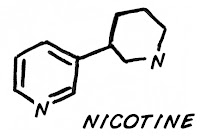In today’s
society, smoking is becoming an alarmingly growing problem. Countless people
die each and every day from smoking. The question is why? Quite often, growing
up you heard the phrase, “it only takes one to get addicted”. The reason being,
the critical component of tobacco-nicotine is extremely addictive. As an increasing problem in today’s society,
it is extremely important that we proactively look for ways to attack
addiction. It is important though that we look for ways to help treat addiction
that is inclusive to other drugs as well such as cocaine, THC,
methamphetamines, etc. Recently, a
speaker in my neuroscience class actually addressed this issue. Daniel S. McGehee discussed a paper of his
that focuses on nicotine’s effect on the human body. McGehee’s experiment
focuses on the dopaminergic pathway; Specifically, it focuses on nicotine’s
interaction with receptors and consequently, its effect on neuron excitability
and synaptic strength. To study these effects, he studied the effect of
nicotine on brain slices from adult male rats.
Results showed that when brain slices are exposed to nicotine,
excitatory synaptic plasticity is induced. Furthermore, exposure to nicotine
also leads to enhanced glutamatergic activity and subsequently changes neuronal
synaptic levels. Even more interesting was the fact that the results of
McGehee’s experiment showed mechanistic similarities between the cocaine and
nicotine pathways. This last piece of information is something I found
extremely interesting. First of all, a study was able to find specifically how
nicotine impacts the brain, but the study was also able to show a significant
amount of overlap between cocaine and nicotine mechanisms. This information is
extremely important because it gives hope to not only deal with addiction
problems in nicotine, but also other drugs as well. If there are multiple drugs
that have similar mechanisms then hopefully soon we can find better
treatments/therapies for drug addiction in general, not only nicotine
specifically. McGehee’s paper became even more interesting when compared to an
article I read on e science news online. The article revolved around a pathway
called ERK. The article notes a study performed by Dr. Jocelyne Caboche. Within
the study it was found that the ERK pathway plays a significant role in
multiple drug addictions. At first, only testing cocaine, they found that
cocaine induces the active form of ERK and in doing so found that it was
actually a common pathway in multiple drugs of abuse. For example they found that the pathway
extended to drugs such as amphetamine, nicotine, morphine, and THC. Specifically, the researchers discovered that
inhibition of ERK activation prevents cocaine induced synaptic plasticity.
Both of these articles focused on
addictive drugs that are heavily prevalent in society today. McGehee’s study
showed that nicotine abuse increases synaptic plasticity and also shows
significant overlap with cocaine mechanisms. While on the other hand, the
article form e science news focuses on the ERK pathway and actually builds upon
the findings from McGehee’s paper. The article on e science news provides a
potential treatment target for the effects seen in McGehee’s experiments and
has helped us to understand that there is a way to prevent excitatory synaptic
plasticity, specifically with the ERK pathway. When combining the information
from both experiments, then I believe that is finally possible for us to tackle
addiction problems caused from drugs such as THC, nicotine, cocaine, etc.
 Overall, McGehee’s paper as well as
the article from e science news are extremely interesting and provide
extraordinary insight into an extremely prevalent problem in today’s society; A
problem that I believe is quite important and constantly growing in today’s
society. Hopefully we can use the information from both these articles to
finally find new treatments for people who deal with drug abuse.
Overall, McGehee’s paper as well as
the article from e science news are extremely interesting and provide
extraordinary insight into an extremely prevalent problem in today’s society; A
problem that I believe is quite important and constantly growing in today’s
society. Hopefully we can use the information from both these articles to
finally find new treatments for people who deal with drug abuse.
Mao, Danyan, Keith Gallagher, and
Daniel S. McGehee. "Nicotine Potentiation of Excitatory Inputs to Ventral
Tegmental Area Dopamine Neurons." The Journal of Neuroscience (2011):
n. pag. Print.
Enzymatic Pathway Common to Drugs
of Abuse Could Lead to New Treatment options." Enzymatic
Pathway Common to Drugs of Abuse Could Lead to New Treatment Options. N.p.,
n.d. Web. 05 Mar. 2016.


No comments:
Post a Comment